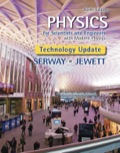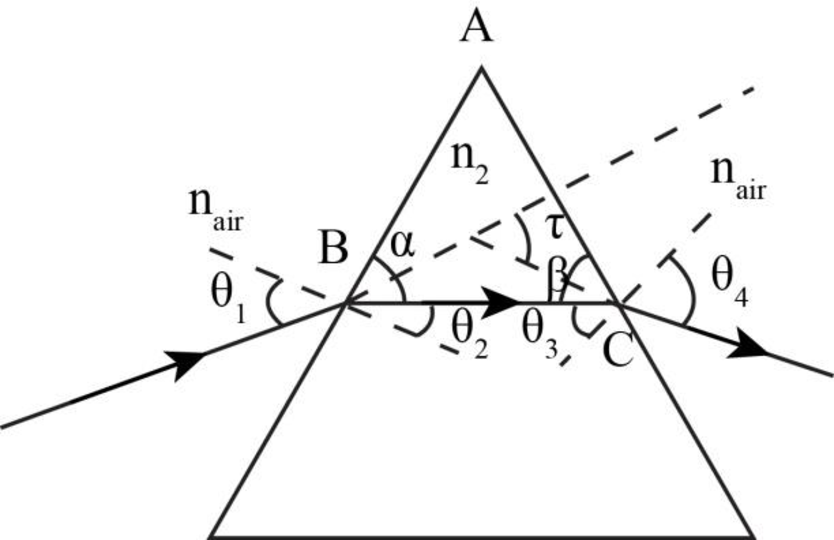
(a)
The angle of refraction at the first surface.
(a)
Answer to Problem 29P
The angle of refraction at the first surface is
Explanation of Solution

Figure-(1)
Write the expression of Snell`s Law.
Here,
Conclusion:
Substitute
Therefore, the angle of refraction at the first surface is
(b)
The angle of incidence at the second surface.
(b)
Answer to Problem 29P
The angle of incidence at the second surface is
Explanation of Solution
From the figure-(1)
Here
Add equation (III) and (IV).
From the figure in
Conclusion:
Substitute equation (V) in equation (IV)
Substitute
Therefore, the angle of incidence at the second surface is
(c)
The angle of refraction at the second surface.
(c)
Answer to Problem 29P
The angle of refraction at the second surface is
Explanation of Solution
Write the expression of Snell`s Law.
Here,
Conclusion:
Substitute
Therefore, the angle of refraction at the second surface is
(d)
The angle between the incident rays and emerging rays.
(d)
Answer to Problem 29P
The angle between the incident and emerging rays is
Explanation of Solution
Write the expression of angle between incident and emerging rays.
Here,
Conclusion:
Substitute
Therefore, the angle between the incident and emerging rays is
Want to see more full solutions like this?
Chapter 35 Solutions
Physics for Scientists and Engineers with Modern Physics Technology Update
- Light traveling in a medium of index of refraction n1 is incident on another medium having an index of refraction n2. Under which of the following conditions can total internal reflection occur at the interface of the two media? (a) The indices of refraction have the relation n2 n1. (b) The indices of refraction have the relation n1 n2. (c) Light travels slower in the second medium than in the first. (d) The angle of incidence is less than the critical angle. (e) The angle of incidence must equal the angle of refraction.arrow_forwardLight enters a prism of crown glass and refracts at an angle of 5.00 with respect to the normal at the interface. The crown glass has a mean index of refraction of 1.51. It is combined with one flint glass prism (n = 1.65) to produce no net deviation. a. Find the apex angle of the flint glass. b. Assume the index of refraction for violet light (v = 430 nm) is nv = 1.528 and the index of refraction for red light (r = 768 nm) is nr = 1.511 for crown glass. For flint glass using the same wavelengths, nv = 1.665 and nr = 1.645. Find the net dispersion.arrow_forwardA ray of light strikes a flat, 2.00-cm-thick block of glass (n = 1.50) at ail angle of 30.0 with respect to the normal (Fig. P22.18). (a) Find the angle of refraction at the lop surface. (b) Find the angle of incidence at the bottom surface and the refracted angle. (c) Find the lateral distance d by which the light beam is shifted. (d) Calculate the speed of light in the glass and (e) the time required for the light to pass through the glass block. (f) Is the travel time through the block affected by the angle of incidence? Explain.arrow_forward
- A fish that is d=d= 2.9 m below the surface looks up and sees a child fishing from the shore. What angle of incidence (θ1) does the ray from the person’s face make with the perpendicular to the water at the point where the ray enters? The angle of refraction (θ2) between the ray in the water and the perpendicular to the water is 35.8°. θ1 = 51.1 What is the height of the person’s head above the water? Assume the person is standing L= 7.4 m away from the point where the incident ray intersects the water. h = marrow_forwardA ray of light strikes the midpoint of one face of an equiangular (60°–60°–60°) glass prism (n = 1.5) at an angle of incidence of 31.4°. (a) Trace the path of the light ray through the glass, and find the angles of incidence and refraction at each surface.First surface: ?incidence = ° ?refraction = ° Second surface: ?incidence = ° ?refraction = ° (b) If a small fraction of light is also reflected at each surface, find the angles of reflection at the surfaces. ?reflection = ° (first surface) ?reflection = ° (second surface)arrow_forwardFor the optical fiber shown in the figure, find the minimum angle of incidence (θi) that will result in total internal reflection if the refractive index for the cladding (n2) is 1.42 and the refractive index of the core is (A.) n1=1.55 and (B.) n1=1.69.arrow_forward
- A ray of light strikes the midpoint of one face of an equiangular (60°–60°–60°) glass prism (n = 1.5) at an angle of incidence of 34.0°. (a) Trace the path of the light ray through the glass, and find the angles of incidence and refraction at each surface.First surface: ?incidence = ?refraction = Second surface: ?incidence = ?refraction = (b) If a small fraction of light is also reflected at each surface, find the angles of reflection at the surfaces. (first surface) ?reflection (second surface) ?reflectionarrow_forwardA ray of light traveling in through the river strikes a floating resin block at an angle of incidence (????); part of the beam is reflected and part of it is refracted. If the reflected and refracted beams make an angle (?=90∘) with each other, and the refractive index of resin is (??????=1.67), calculate ???? in degrees given refractive index of river water is ??????=1.33. Choose the closest answer.arrow_forwardA flashlight is held at the edge of a swimming pool at a height h = 1.9 m such that it’s beam makes an angle of θ = 46 degrees with respect to the water’s surface. The pool is d = 1.25 m deep and the index of refraction for air and water are n1 = 1 and n2 = 1.33, respectively. h = 1.9 m d = 1.25 m θ = 46 degrees What is the horizontal distance, D, from the edge of the pool to the point on the bottom of the pool where the light strikes? Write your answer in m. D =arrow_forward
 Principles of Physics: A Calculus-Based TextPhysicsISBN:9781133104261Author:Raymond A. Serway, John W. JewettPublisher:Cengage Learning
Principles of Physics: A Calculus-Based TextPhysicsISBN:9781133104261Author:Raymond A. Serway, John W. JewettPublisher:Cengage Learning Physics for Scientists and Engineers: Foundations...PhysicsISBN:9781133939146Author:Katz, Debora M.Publisher:Cengage Learning
Physics for Scientists and Engineers: Foundations...PhysicsISBN:9781133939146Author:Katz, Debora M.Publisher:Cengage Learning Physics for Scientists and Engineers with Modern ...PhysicsISBN:9781337553292Author:Raymond A. Serway, John W. JewettPublisher:Cengage Learning
Physics for Scientists and Engineers with Modern ...PhysicsISBN:9781337553292Author:Raymond A. Serway, John W. JewettPublisher:Cengage Learning Physics for Scientists and EngineersPhysicsISBN:9781337553278Author:Raymond A. Serway, John W. JewettPublisher:Cengage Learning
Physics for Scientists and EngineersPhysicsISBN:9781337553278Author:Raymond A. Serway, John W. JewettPublisher:Cengage Learning College PhysicsPhysicsISBN:9781285737027Author:Raymond A. Serway, Chris VuillePublisher:Cengage Learning
College PhysicsPhysicsISBN:9781285737027Author:Raymond A. Serway, Chris VuillePublisher:Cengage Learning College PhysicsPhysicsISBN:9781305952300Author:Raymond A. Serway, Chris VuillePublisher:Cengage Learning
College PhysicsPhysicsISBN:9781305952300Author:Raymond A. Serway, Chris VuillePublisher:Cengage Learning





